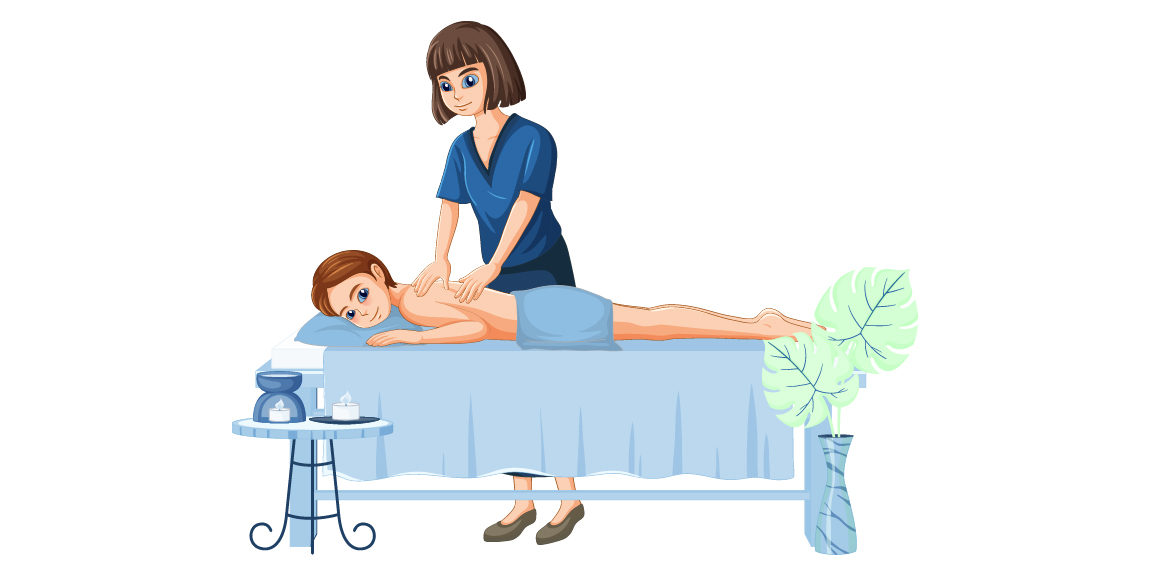When it comes to relaxation and stress relief, few things can compare to a soothing massage. In the world of massage therapy, two popular styles that often come up for comparison are Swedish and Thai massage. Both techniques offer unique benefits and approaches, making them popular choices for those looking to unwind and rejuvenate. In this blog post, we will take a deep dive into Swedish compared with Thai massage techniques, exploring their origins, key techniques, benefits, and ideal candidates for each type of massage
Origins and Philosophies Behind the Techniques
Swedish massage traces its inception to Western traditions and different cultural traditions, created by Per Henrik Ling, a Swedish physiologist, in the 19th century. It is designed with the objective of enhancing relaxation, circulation, and easing muscle tension, employing methods such as effleurage, petrissage, and friction techniques. This form of massage therapy embodies a holistic approach to healing, focusing on the physical aspects to foster an environment of wellness and tranquility.
In contrast, Thai massage, deeply rooted in the healing traditions of Thailand, integrates the philosophies of traditional Thai medicine, including influences from yoga, acupressure, and Ayurveda. This holistic approach is aimed at enhancing the body’s energy flow, boosting flexibility, and promoting a state of balanced well-being. Unlike its Western counterpart, Thai massage delves into the energetic and spiritual dimensions, encouraging the body’s natural healing process through the stimulation of energy lines known as ‘Sen’ lines, and employing a combination of pressure point work, stretching techniques, and dynamic body movements.
These distinct origins and underlying philosophies highlight the diverse approaches to wellness and therapy embodied by Swedish and Thai massage. While both prioritize the health and relaxation of the recipient, they differ significantly in techniques, execution, and the philosophies they embrace, offering varied paths to achieving a sense of well-being and balance in the body and mind.

Key Techniques of Swedish Massage
In the practice of Swedish massage, a variety of specific movements are employed to gently yet effectively address the body’s needs. The foundational technique, effleurage, consists of smooth, gliding strokes along the length of the muscles, setting a tone of relaxation and promoting blood flow towards the heart. This is often the starting point of the massage, warming up the muscles and preparing them for deeper work. Following effleurage, petrissage takes center stage; this technique involves the kneading and squeezing of muscles, which aids in the release of toxins from muscle tissues and the breaking up of muscle knots. Another key method, friction, involves the use of deep, circular motions targeting specific areas of concern, creating heat to increase blood flow and encourage healing in those regions. Additionally, Swedish massage incorporates rhythmic tapping and slight shaking movements designed to invigorate and loosen up the muscles further.
These techniques collectively contribute to the overarching goals of Swedish massage: to alleviate muscle tension, enhance circulation, and promote an enhanced state of relaxation. Through these carefully executed movements, therapists are able to tailor the massage to address individual needs, whether the focus is on reducing stress, easing muscle soreness, or enhancing physical well-being. The use of oil or lotion facilitates the smooth execution of these techniques, ensuring a seamless and comfortable experience for the recipient. This thoughtful combination of movements makes Swedish massage not just a method for relaxation but a comprehensive approach to supporting the body’s natural healing processes and improving overall health.
The Unique Elements of Thai Massage
Distinct from its Swedish counterpart, Thai massage incorporates a holistic approach that treats the body as a network of energy lines. With the client dressed in comfortable, loose-fitting clothes, the experience takes place on a mat laid out on the floor, encouraging a more active participation than the passive reception found in Swedish massage. Therapists use a blend of their body parts—including hands, feet, elbows, and knees—to exert pressure and manipulate the body into various stretches and poses that echo the movements of yoga. This method not only aims to relieve muscular tension but also seeks to enhance the flow of energy or ‘chi’ throughout the body.
A key aspect of Thai massage is its focus on the Sen lines, believed to be pathways for the flow of energy. By targeting these lines with pressure and stretching, the massage works to unblock any energy obstructions, thereby promoting a better balance of the body’s vital forces and enhancing overall well-being. The interaction between therapist and client in Thai massage is also notably dynamic, involving a series of movements that require flexibility and participation from the client, such as being moved into various yoga-like positions. This active engagement is essential for reaching deeper levels of muscle tension and improving range of motion.
Through these distinctive techniques, Thai massage offers an invigorating experience that goes beyond mere physical relaxation, targeting mental and spiritual harmony as well. This comprehensive approach ensures a rejuvenating session that aligns the body, mind, and spirit, making it a unique and deeply therapeutic practice.
Comparing the Benefits of Each Massage Style
Swedish and Thai massages offer distinct advantages tailored to different personal wellness goals. Swedish massage, with its gentle and rhythmical techniques, is primarily aimed at fostering a sense of deep relaxation and tranquility. It effectively reduces muscle tension, aids in the elimination of bodily toxins, and enhances blood circulation. This type of massage is especially beneficial for those seeking a peaceful retreat from the stresses of daily life, offering a therapeutic touch that nurtures both body and soul.
Conversely, Thai massage adopts a more holistic and vigorous approach, addressing the body’s energy system alongside physical ailments. It stands out for its ability to improve flexibility and range of motion through its incorporation of stretching movements reminiscent of yoga. This massage style goes beyond surface-level relaxation, aiming to restore the flow of energy throughout the body, which can lead to improved mental clarity and emotional balance. For individuals suffering from chronic pain or stiffness, Thai massage provides a dynamic solution by applying deeper pressure and targeted stretching to relieve discomfort and enhance physical capabilities.
Each massage style, with its unique techniques and outcomes, caters to a broad spectrum of wellness objectives. Whether one is in pursuit of mental calm and physical ease or seeking to invigorate the body’s internal energy and mobility, both Swedish and Thai massages offer paths to achieve personal health and relaxation goals, emphasizing the importance of selecting the right type of massage to align with individual wellness needs.
Ideal Candidates for Each Type of Massage
For those exploring massage therapy options, identifying the ideal candidates for Swedish and Thai massages is crucial for maximizing the benefits of each. Swedish massage is particularly beneficial for individuals seeking relaxation and relief from muscle tension without the intensity of deep tissue techniques. This makes it an excellent choice for newcomers to massage therapy, people with sensitive skin or low pain tolerance, and anyone in need of a gentle, nurturing touch to alleviate stress and promote overall wellness.
On the flip side, Thai massage is more suited for those who appreciate a more active and vigorous form of bodywork. Its unique combination of stretching, pressure points, and movement makes it ideal for individuals with a higher level of physical activity, such as athletes or fitness enthusiasts, who require a deeper focus on flexibility and muscle recovery. Additionally, people with chronic pain conditions that benefit from movement and those interested in the energetic and holistic aspects of their well-being will find Thai massage to be particularly advantageous.
Understanding these distinctions can help individuals make informed decisions about which type of massage therapy will best meet their needs, whether they are looking to unwind and relax with a Swedish massage or engage in a more dynamic and restorative experience with Thai massage. Each style offers specific benefits tailored to different preferences and health goals, ensuring that there is a massage therapy approach suitable for everyone.
Preparing for Your Massage Experience
To maximize the benefits of your chosen massage therapy, a little preparation can go a long way. Open dialogue with your massage therapist is essential; discuss any specific health issues, pain points, or goals you have for the session. This helps tailor the experience to your needs, ensuring the most beneficial outcome. Arriving early allows you to relax and mentally prepare for your session, enhancing the therapeutic effect of the massage. Comfort is key, so choosing attire that is loose and breathable can significantly impact your level of comfort, especially for Thai massage, which involves more active participation and movement. Staying well-hydrated before and after your massage promotes the flushing of toxins released from the muscles during the session and aids in the recovery process. Remember, your massage is a time for healing and relaxation, so taking these steps beforehand can help create the most serene and beneficial experience possible.

Deep tissue massage is a therapeutic technique that utilizes deep pressure to target tense and tight muscles throughout the entire body. Incorporating yoga-like stretches and hot stone massage, this modality aims at pain management and relief, employing sweeping strokes and percussion movements to release tension and improve energy levels. Unlike traditional Western massages, deep tissue focuses on accessing deeper layers of muscle and clearing energy pathways, offering a range of benefits beyond relaxation. With its emphasis on medium pressure and addressing specific areas of discomfort, it’s often recommended for individuals with medical conditions or chronic muscle tension. Clients typically wear comfortable clothing during sessions, and the practice may include yoga-like poses and gentle stretching, making it a holistic and effective alternative medicine approach.
There are various types of massages tailored to meet different needs and preferences. Some massages, like deep tissue, involve strong pressure to alleviate muscle stiffness and tension. Others focus on rhythmic or sustained pressure to promote relaxation and release blocked energy channels throughout the body. These techniques target stiff muscles, promoting muscle relaxation and flexibility while providing an energy boost. By applying specific pressure techniques, massages not only address physical discomfort but also contribute to overall well-being and vitality.
Ayurvedic Massage, deeply rooted in ancient Indian tradition, is not just a physical therapy but a holistic approach to healing and well-being. It blends seamlessly with the principles of Ayurveda, focusing on balancing the body, mind, and spirit. Unlike a basic massage session, Ayurvedic Massage is considered a curative practice, tailored to individual needs and imbalances. Utilizing herbal oils and specific techniques, it aims to detoxify, rejuvenate, and restore harmony within the body. This medical massage is an art, with practitioners trained in the intricate knowledge of pressure points and energy flow. Whether it’s a localized treatment or a full-body massage, Ayurvedic Massage offers a deeply therapeutic experience that goes beyond mere relaxation, aligning with the ancient wisdom of holistic healing.
Frequently Asked Questions
Swedish massage primarily aims to promote relaxation and improve circulation throughout the body using a variety of techniques including long strokes, kneading, deep circular movements, and vibration. It is particularly beneficial for releasing muscle tension and can be deeply soothing. In contrast, Thai massage focuses on enhancing the flow of energy through the body along specified energy lines, using techniques that include stretching, pressing, and folding. Thai massage aims to improve flexibility, relieve muscle and joint tension, and balance the body’s energy systems.
Swedish massage typically involves the use of oils or lotions to help the massage therapist’s hands glide smoothly over the skin, facilitating gentle yet firm manipulations of the muscles and other soft tissues of the body. Thai massage is quite distinct in its approach; it is performed with the recipient fully clothed, often on a padded mat on the floor. It employs a combination of pressing, stretching, and twisting techniques, without the use of any oils or lotions.
During a Swedish massage, the recipient usually lies on a massage table, either partially or fully undressed, and covered with a sheet or towel for privacy and warmth. On the other hand, Thai massage is generally performed with the recipient fully clothed, lying on a floor mat. Throughout the session, the massage therapist moves the recipient into various positions that include lying on their back, stomach, sides, and even sitting up.
Swedish massage was developed in the early 19th century by Per Henrik Ling, a Swedish physiologist. It incorporates techniques that were systematized and combined with scientific knowledge of anatomy and physiology to create what is known globally as Swedish massage. Thai massage, meanwhile, has its roots deeply planted in the traditions of ancient Indian medicine. It is said to have been developed by Jivaka Kumar Bhaccha, a physician to the Buddha, over 2,500 years ago. Thai massage blends influences from Ayurvedic, Chinese, and Southeast Asian bodywork traditions.
Individuals seeking relaxation and tension relief in a soothing setting may prefer Swedish massage, as it focuses on relieving muscle stress and enhancing blood circulation in a more passive manner. It is ideal for those new to massage, those with sensitive bodies, or those simply looking to unwind. Conversely, Thai massage is suitable for those looking to increase their flexibility, relieve deep muscular and joint distress, or improve their body’s energy flow. It can be more physically and energetically engaging, making it a good choice for individuals who enjoy active forms of bodywork.








